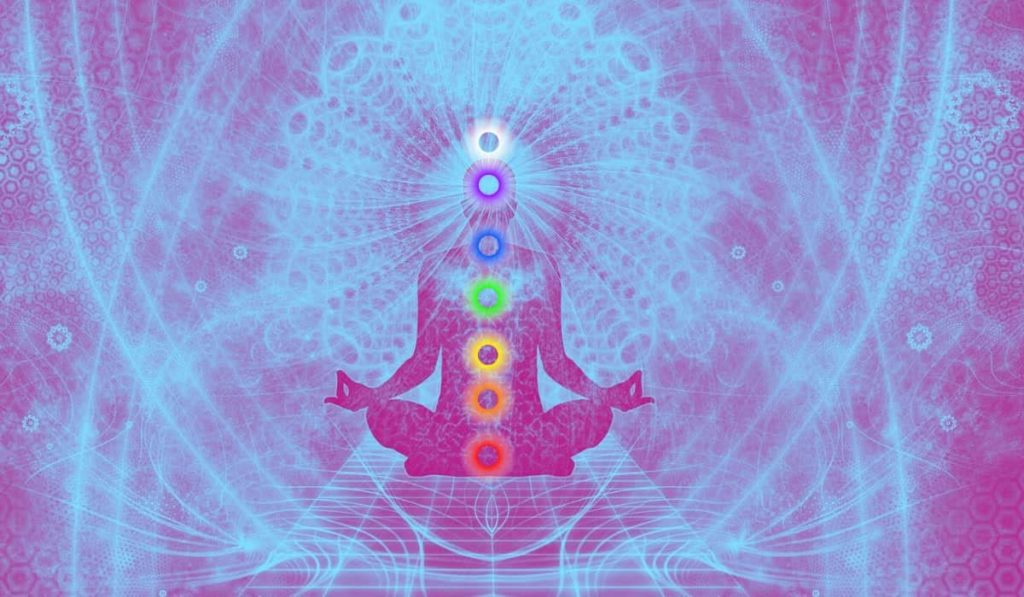We started our look at the seven out of 10 chakras we possess by examining the spleen or sacral chakra, which is the centre responsible for absorbing vitality into the body and redistributing it. We now turn our attention to the first centre, or chakra, at the base of the spine. It is a conduit for a primary force, which radiates in four spokes, making the centre appear to be divided into quadrants, with hollows between them, like a cross, a symbol, which is often used to represent the centre.
The diagram of the Base of the Spine Centre is for a normal person. The kundalini functions as a seat for both the Emotional and Etheric bodies. Its appearance is of a “fiery orange-red” disc. It has four spokes. It should be noted that the Kundalini has seven degrees of force; were you in any doubt?
When aroused into full activity, this centre is fiery orange-red corresponding closely with the stream of dark red and orange vitality, which comes to it from the spleen centre. It may be mentioned that in every case there is a similar correspondence between the colour of the stream of vitality flowing into a centre and the colour of the centre itself.
In this diagram, the Base of the Spine Centre of a developed person is represented. In addition to the orange and darker reds, there is also some dark purple vitality flowing into this centre. It is as though the spectrum has been bent round the circle and the colours have begun again on a lower octave. From this centre the orange-red ray flows to the generative organs, energising the sexual nature: it also seems to enter the blood and maintain the heat of the body.
A very remarkable and important effect can be produced by a person who persistently refuses to yield to their lower, animal nature. By long and determined effort the orange-red ray can be deflected upwards to the brain, where all three constituents undergo a profound modification. The orange is raised into pure yellow and intensifies the intellectual powers. The dark red becomes crimson and increases the power of unselfish affection; the dark purple is transmuted into a beautiful pale violet, quickening the spiritual part of the nature. The term “spiritual” is used loosely here and does not refer to the 3rd triad.
The seat of Kundalini, the Serpent-Fire, is at the base of the spine centre. This will be dealt with in a later presentation. For the present we should just note that a person who has achieved the transmutation just mentioned, will find that sensual desires no longer trouble them and when it becomes necessary for them to arouse the serpent fire they will be free from the most serious of dangers of that process. When a person has finally completed the change, the orange-red ray passes straight into the centre at the base of the spine and runs upwards through the hollow of the vertebral column and into the brain. A flaming cross is a symbol sometimes used to represent the serpent fire residing at the base of the spine centre. The root chakra should not be forced in any way. It will activate when the time is right and this is right at the end of the initiatory process of the (i3). Idiots who attempt to raise their kundalini energy before they have transformed their “base nature” send the wrong energy up their spine to disastrous consequences, even resulting in death. Not only can this seriously rain on your parade in this incarnation, but it will have residual effects in future ones.
Moving on, the third centre, at the navel or solar plexus, receives a primary force which radiates in ten directions, there being ten undulations or petals. Its predominant colour is a curious blending of various shades of yellow, though there is also a great deal of orange in it. It receives the orange ray from the sacral centre, and that ray also floods the abdomen, vivifying the liver, kidneys, intestines and the digestive apparatus generally, centring especially in the solar plexus. The overall appearance of this centre ends up being yellow.
The diagram shows the ten spokes of the chakra. As chakras link one envelope to another, the centre located in the Emotional Envelope transits feelings and general sensitivities. At the etheric end of the connection, the feelings received are emotional influences. As mentioned, the appearance of this chakra shows various shades of yellow, with much orange but ending up looking yellow overall.
The centre is closely associated with feelings and emotions of various kinds. The corresponding emotional centre, when awakened, gives the power of feeling, a sensitiveness to all sorts of influences, though without as yet anything like the definite comprehension that comes from the faculties corresponding to seeing or hearing. When, therefore, the etheric centre becomes active, the person begins in the physical body to be conscious of emotional influences, vaguely feeling friendliness or hostility, or that some places are pleasant and others unpleasant, but without knowing why. Here we are of course referring to the gradual evolution of the human monad and not what has been developed over hundreds of thousands of years in current humanity. The Sanskrit name for this centre is Manipura. Let us now pass on to the heart chakra.
DIAGRAM VII Heart Centre
The image presented shows a representation of the heart chakra, with its predominant green colour. This ray permeates into the blood and is carried all over the body with it. The function of the heart chakra in the emotional envelope is to allow a person with the power to comprehend and sympathise with, and so instinctively understand, the feelings of other emotional entities. When awakened, the function of this chakra in the etheric envelope is to allow the monad to distinguish the feelings of others. It makes a person aware, in their physical consciousness, of the joys and sorrows of others and sometimes even causes them to reproduce in themselves by sympathy, their physical aches and pains. The Sanskrit for this chakra is Anahata. This chakra has twelve spokes.
The heart chakra receives energy from the solar plexus centre. When the current is full and strong it produces strength and regularity in the heart’s function. Flowing around the heart chakra, the energy also interpenetrates the blood and thus is carried all over the body. It also passes on to the brain and permeates it, though directing itself principally to the twelve-petalled flower in the middle of the seventh or highest centre. In the brain, it confers the power of high philosophical and metaphysical thought.
We now step up to the Throat Chakra; this chakra, the fifth, has sixteen spokes and therefore sixteen petals or divisions. In colour, it shows a good deal of blue, but its general appearance is silvery and gleaming, not unlike moonlight on rippling water. It receives the violet-blue ray from the sacral chakra. This ray then appears to divide, the light blue remaining to course through and vivify the throat centre, while the dark blue and violet pass on to the brain. The light blue ray gives health to the region of the throat, the strength and elasticity of the vocal cords of a great singer or speaker, for example, being accompanied by the special brilliance and activity of this ray.
The dark blue expends itself in the lower central parts of the brain, while the violet floods the upper part and appears to give special vigour to the chakra at the top of the head, diffusing itself chiefly through the nine hundred and sixty petals of the outer part of the centre. Ordinary thought is stimulated by the blue ray, mingled with part of the green from the heart centre. In some forms of autism, the yellow and blue-violet ray energy flows to the brain and is almost inhibited. Thought and emotion of a high spiritual type seem to depend largely upon the violet ray.
The awakening of the corresponding emotional centre gives the power of hearing on the emotional plane (clairaudience), that is to say, the faculty which produces in the emotional world the effect similar to that which in the physical world we call hearing.
When this etheric centre is aroused, the person in their physical consciousness hears voices, which sometimes make all kinds of suggestions to them. They may hear music or other less pleasant sounds. When fully working, it makes a person clairaudient so far as the etheric and emotional planes are concerned. The Sanskrit name for this centre is Visuddha.
The sixth centre, that between the eyebrows, has ninety-six spokes. In Indian books, however, it is mentioned as having only two petals, this being probably because it presents the appearance of being divided into two halves. Of these, one is predominantly rose-coloured, though with a great deal of yellow in it, and the other predominantly a kind of purplish-blue.
I have been unable to find any specific description of the source of the pranic stream which flows into this centre, though it is mentioned in some literature as being purplish-blue in appearance in one half of the centre. This agrees closely with the colours of the special types of vitality that vivify it. This would seem to indicate the dark blue (and violet?) ray, which passes the throat centre and proceeds to the brain. This is why in the diagrams presented, there are no energy flows indicated. The development of the corresponding emotional centre confers the power to perceive, definitely, the nature and shape of emotional objects, instead of vaguely sensing their presence.
The awakening of this etheric centre causes a person to see objects and to have various sorts of waking visions of places or people. When just beginning to awaken, landscapes and clouds of colour are half-perceived. When fully developed it brings about a higher form of clairvoyance than experienced through the navel chakra. The remarkable faculty of magnification of vision, or its converse, is associated with this centre and will be described further in the presentation on Etheric Sight. In Sanskrit, this centre is known as Ajna.
In the next presentation, we will conclude our look at the seven out of 10 chakras by reviewing the form and function of the Crown chakra.


